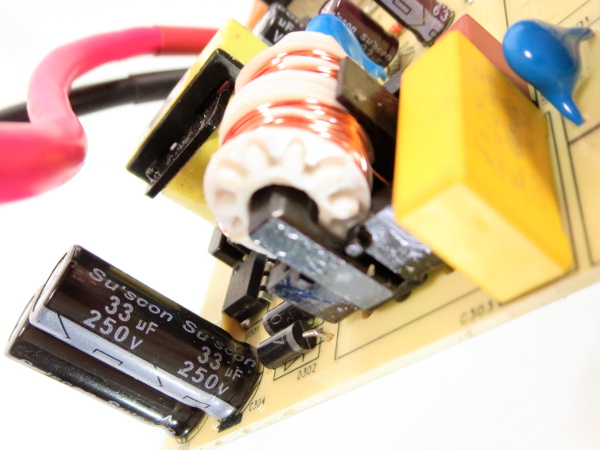CyberPower LX1500GU-FC UPS Tear-Down
Shaving Pennies
To put it bluntly, I feel like the LX1500 was built down to a price. There's the power cord using #16 wires instead of #14, a 15A breaker instead of the breaker that matches the cord, surge-only outlets built like an afterthought, no EMI filtering for attached devices, LAN surge suppression done in the cheapest way possible with minimal concern for signal integrity and the same for coax protection.
On the plus side, the main reason most people buy a device like this is for battery backup, and in that department the LX1500 delivers: good batteries, good waveform (as far as modified sine waves go) and a status display that covers the essentials. Some people may take issue with Su'scon capacitors, but the brand does not appear to have been involved in notable capacitor failure events since 2006, so I'll take that to mean its capacitors are alright when used correctly, which seems to be the case here.
Would I recommend this UPS? Only, if you do not mind writing off the coax surge protection and possibly the network protection too. What do you, the readers, think? And what would you like to see us tear-down in the future?
MORE: SurgeX SA-1810 Tear-Down
MORE: Tripp-Lite isobar Surge Protector Tear-Down
MORE: Monster PowerCenter HT 800G Tear-Down
Get Tom's Hardware's best news and in-depth reviews, straight to your inbox.
-
Nuckles_56 This was really interesting thanks Daniel, I was surprised how many corners they cut when building this and I guess if I decide to buy a UPS, I'll have to do some serious research to ensure that the one I buy isn't like thisReply -
Daniel Sauvageau Reply
If you buy an UPS for the UPS function only, you can ignore the gimmick extras and that makes it ok-ish in my book. To get 9AH batteries from APC or Tripp-Lite, you need to spend 20-30% more,17616866 said:I was surprised how many corners they cut when building this -
Onus I would love to see a teardown of one of Cyberpower's APFC units. My Delta-built SG-650 WILL NOT run on a cheap UPS, but runs fine on a Cyberpower 1500PFCLCD (and on a smaller one as well). I'm curious as to how close to true-sine it really is; I believe it is a clipped-triangle, but I don't have an oscilloscope myself to check it.Reply
What I saw in this review was not a "modified sine wave;" it looked a lot like a square wave with some funk at the corners.
-
gamebrigada I'm raging about cyberpower right now. Started buying their stuff about 2 and a half years ago because of good pricing. I have probably a dozen UPS's from them, 3 have failed in the past 3 months. Not looking good for the brand so far. Especially when I've never had an APC ups fail for any reason other than its batteries, with 10 year old models still holding their own.Reply -
Epsilon_0EVP Not being extremely knowledgeable in electrical circuitry, I find it extremely alarming that every teardown of a surge protector or battery backup I have seen on this site points out glaring manufacturing issues, cut corners, and overall shoddy design and workmanship. It makes me question how much safer my electronics actually are when connected to these devices, given that I seem to be eliminating one possible point of failure by introducing another one. Could anyone more knowledgeable provide some thoughts on this?Reply -
ammaross I disregard the ethernet and coax passthrus (for obvious, and now shown, reasons). However, I'd love to see a teardown of the Pure Sine wave units from CyberPower and APC (APC is my pref brand, but not usually a cheap to aquire, whereas CP is usually on a great sale somewhat often).Reply -
Daniel Sauvageau Reply
Most of them, sure. All of them? No. The SurgeArrest Performance, both the old model from 10+ years ago and the newer model currently on the market are quite decent for $30-40 US. For $10-20 more, the Tripp-Lite isobar knocks build quality up a few notches with proper power outlets, extruded aluminum body and beefier filter inductors. (Although the "isolated outlet banks" turned out to be questionable.) The SurgeX unit kicked that up a few more notches, although its $400 price tag is a "little" steep.17618830 said:Not being extremely knowledgeable in electrical circuitry, I find it extremely alarming that every teardown of a surge protector or battery backup I have seen on this site points out glaring manufacturing issues, cut corners, and overall shoddy design and workmanship.
Right now, I'm trying to keep an eye on sales. While I was putting the LX1500 story together, I missed a sale on the PFC variant for only $10 extra. I didn't want to buy $400+ worth of UPS before knowing whether interest would be there. -
Daniel Sauvageau Reply
They call it "modified sine" because the bipolar return-to-zero waveform has lower total harmonic content than a plain square wave. It may not look sinusoidal but as far as the Fourrier transform is concerned, it should be close enough for most purposes.17618266 said:What I saw in this review was not a "modified sine wave;" it looked a lot like a square wave with some funk at the corners.
As for the "funk at the corners", that's likely the transformer's inductance resonating with the PSU's EMI filter capacitors. There isn't much of it on the APC since the old BX1000 drives HVDC to its output through an H-bridge, not much bulk inductance for load caps to resonate with there.
